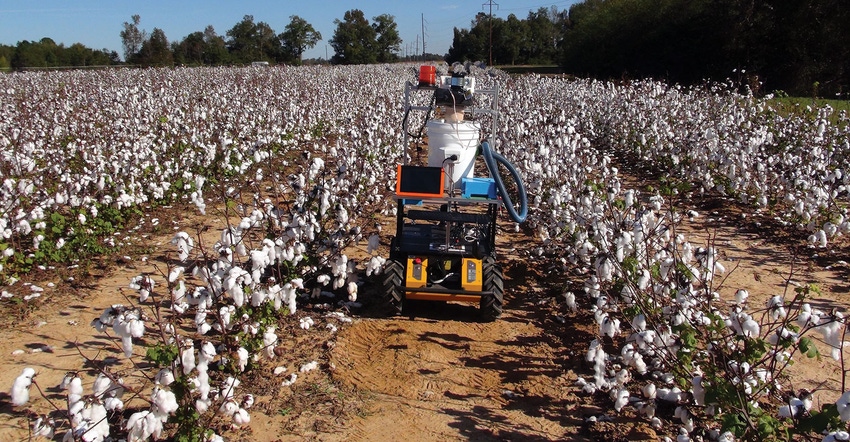
Although Cotton Incorporated’s Dr. Ed Barnes may have felt like a fish out of water addressing peanut farmers at this year’s Southern Peanut Growers Conference, he knows that in addition to growing peanuts, many of them grow cotton for rotation.
Barnes talked about robotics research Cotton Incorporated is funding at the University of Georgia as part of a larger belt-wide initiative he designed to address the vexing farm labor shortage problem and the increasing herbicide-resistant weed issue.
“The labor shortage is becoming increasingly problematic, and I firmly believe the first robots to appear on farming operations in the U.S. will be there to control herbicide-resistant weeds,” says Barnes. Weed scientists say that will happen sooner rather than later, and robotics will be able to help.”
Artificial intelligence (AI) technology continues to improve and directly supports the advancement of robotics. “AI will be needed to help link differences detected between plants in the field and the genes driving those differences,” says Barnes.
“One of our projects is utilizing a tractor fitted with a Lidar detection system that works like radar but uses lasers to create 3-D images of a cotton plant. We’ll be able to use that imaging to develop robots that can identify and grab open bolls off the plant when it comes time to harvest, but this technology has crop crossover uses.”
Unmanned aerial vehicle (UAV) use in farming and research is expanding rapidly. Barnes admits they are essentially flying robots. “I don’t think we have yet captured the full value of UAVs on the farm level. They are difficult to fly without computer assistance,” says Barnes. “We recently flew one that created a high-resolution image of a field’s plant canopy that can be used to quantify plant growth rates. This is really pushing the research envelope.”
Barnes has another cooperative researcher using a spider sprayer outfitted with an infrared thermometer, sensors that can measure crop reflectance, a small-scale weather station, and instruments to measure plant heights.
“As this sprayer rolls across the breeder plots, it’s characterizing and quantifying all of the cotton plants,” says Barnes. “We even have a researcher who placed a cotton plant on a revolving turntable and created a 3-dimensional model that can be used to simulate field environments to train machine vision systems.”
Many teenagers today are playing “game environment” videos that are more lifelike than ever before. Barnes is funding one project where a video game “engine” was used to place those cotton plant models into a gamer’s environment. “We had to vary the lighting and soil background, but this will allow us to accelerate the development of this technology,” says Barnes. “Many of today’s biggest ag companies are getting into the ‘next generation of technology’ ballgame.”
John Deere just purchased Blue River, a company that is using machine-vision to control weed applications. CNH, a global leader in capital goods that includes ag equipment, has an autonomous tractor initiative. “A company called Boston Dynamics, through a project funded by the defense department, has a prototype self-autonomous robot that can jump and flip like a trained gymnast,” says Barnes. “These types of technologies are here today and are precursors to ag developments that will be on farms one day.”
Harvesters, big data, competition
Today’s on-board module harvesters collect volumes of data and that data has on-farm value. Barnes is looking for producers who will agree to volunteer their operations to conduct virtual variety trials. “If someone that has an on-board module harvester is open to this type of research, I would like to talk to them.”
The price tag for today’s top-of-the-line on-board model harvester is approaching $1 million. “If a farmer is going to invest in this machine, they better have at least 2,000 acres of row crop ground dedicated to cotton,” says Barnes. “It’s a heavy machine. It brings so much to the farm gate and beyond, but it also has some hurdles — like compaction — that must be considered.”
Buying a new harvester this year may be difficult. “Even if you can order one, it will be the CP690 because that’s the only model available in the U.S.,” says Barnes. “We all know it can only be used for about two months out of each year. There again, not the most optimum situation that could lend itself to robotic harvesting.”
Myriad companies are bringing robotics to the marketplace, which should usher in competition. “It’s about 50 days between the time that first boll opens and the time harvest is complete. I don’t have to remind anyone what happens during a hurricane if those bolls are still on the plant,” says Barnes. “Robotics would reduce the risk of both yield and quality loss. I understand it’s scalable, but we’re working on the economics of it right now. It’s coming.”
A robotic platform could also be used for weed control applications and to scout for pests. Robotics have implications for ginning as well. “If we can more precisely harvest cotton and avoid bringing a lot of foreign material into the gin, we can reduce the amount of cleaning a gin has to do to the fiber,” says Barnes. “That will save some money and improve quality.”
Cotton Incorporated has projects across the Cotton Belt with engineers who are working on robotics platforms. They even have a geneticist who claims if the engineers can’t solve part of a vision identification problem, he can modify the plant to make the bolls more accessible. “We understand economics is a major part of this process, and we want to make sure robotics will be more economically beneficial than what’s currently being used in terms of farm profitability, but they are coming,” concludes Barnes.
About the Author(s)
You May Also Like




